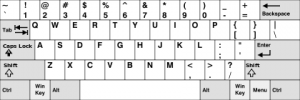Have you ever wondered what the names are for all those extra symbols on your keyboard? Many of these symbols are punctuation marks of one kind or another, while some are just symbols that are commonly used in writing. Below I’ve made a table that gives you the names of all of these symbols. The first eight symbols in this table are common punctuation marks. Punctuation marks are the symbols that give organization to written language and are therefore very necessary. They also help us figure out intonation* and where to pause when we are reading written language aloud. Following these first eight punctuation marks are different types of brackets, which are also a kind of punctuation mark. The remaining items included in the table are symbols that are not punctuation marks, but symbols that are used enough in everyday writing that they are included on a standard American computer keyboard. Did you know that keyboards are different in different countries? American keyboards have what is called the “ANSI” layout. This is what that layout generally looks like:

On this keyboard you can see where all the punctuation marks and symbols are located. Below in the table are the names for these symbols.
| . |
period (US) or full stop (UK) |
| , |
comma |
| ! |
exclamation mark |
| ? |
question mark |
| : |
colon |
| ; |
semicolon |
| “ ” |
quotation marks |
| ‘ ’ |
single quotes |
| ( ) |
parentheses |
| { } |
curved brackets |
| [ ] |
square brackets |
| @ |
“at” sign or symbol |
| * |
asterisk |
| ~ |
tilde |
| / |
slash |
| – |
dash |
| # |
pound sign |
| $ |
dollar sign |
| & |
and or ampersand |
* producing or uttering tones/sound accurately






Comments:
Diego:
‘ampersand’ is not a name for @, but for &.
According to Wikipedia, a possible name for @ is ‘ampersat’.
gabriele:
@Diego Hi Diego,
Thank you for your comment – great catch! Thank you for letting me know about the mistake I made. I changed the table in the post so that it is correct now.
I hope you are enjoying the blog.
-Erin
ibrahim halid zolikugli:
i have learnt a lot from this blog. Kudos to the blogger. My name is Halid and am from Ghana
Joyce is my name, i want to learn more about English and to improve my gramer and spelling. So if u can help me. Thank u:
I love the teaching and i have learn more
Ernest M from Zanbia:
Does this sign #mean pound as shown on this table.
ibrahim missinga:
I like this blog
Lon Safko:
The “pound sign” isn’t called a pound sign or a hash mark or a tic-tac-toe, it’s called an octothorpe. :o)
John:
# = hash symbol; £ = Pound Sterling n’est pas?
John Gil:
The “minus” as in 45-30=15; the “dash” as
in anti-virus; the “underscore” as docs_tech,
whay are there Alt + number code as per example
“semicolon” ; is Alt +59.
Tony:
What is the proper use for ` (appears on tilda key)
Clement:
Please I don’t really no typing fast … If you can help me to type fast